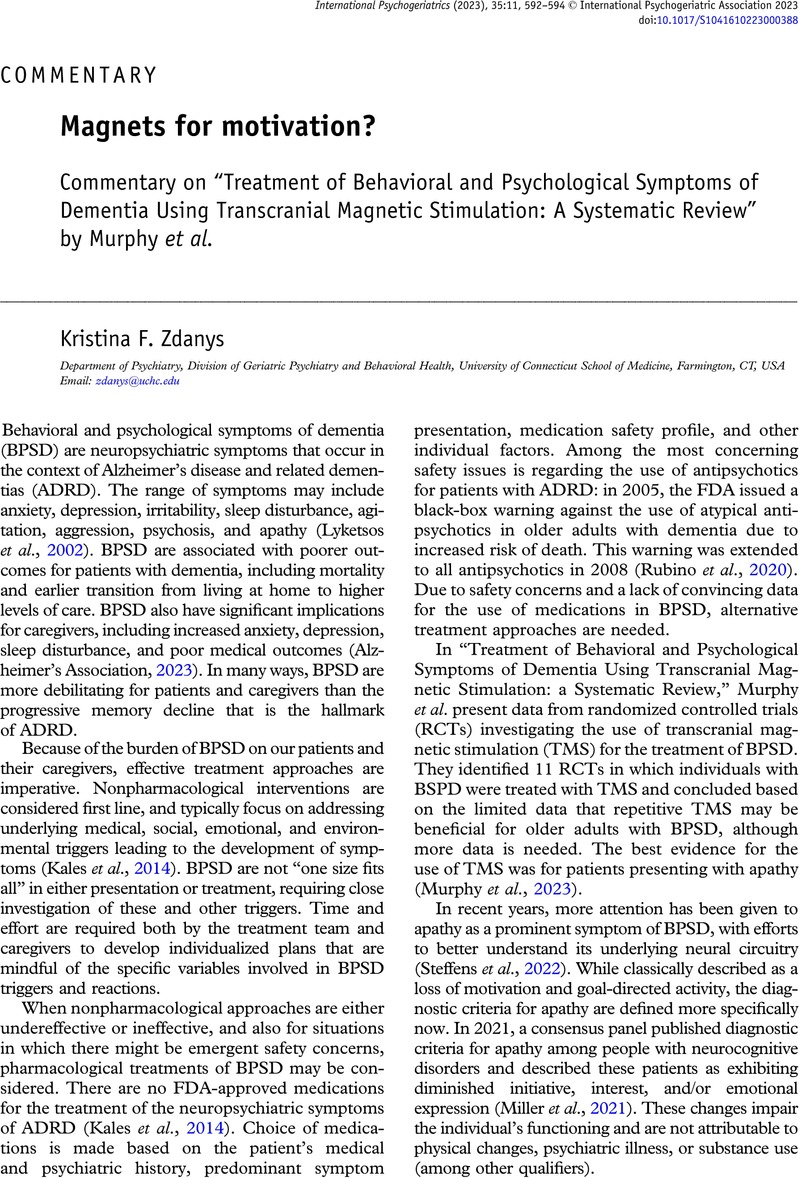No CrossRef data available.
Article contents
Magnets for motivation?
Commentary on “Treatment of Behavioral and Psychological Symptoms of Dementia Using Transcranial Magnetic Stimulation: A Systematic Review” by Murphy et al.
Published online by Cambridge University Press: 19 April 2023
Abstract
An abstract is not available for this content so a preview has been provided. Please use the Get access link above for information on how to access this content.

- Type
- Commentary
- Information
- International Psychogeriatrics , Volume 35 , Special Issue 11: Issue Theme: Neuropsychiatric Symptoms of Mild and Major Neurocognitive Disorders , November 2023 , pp. 592 - 594
- Copyright
- © International Psychogeriatric Association 2023
References
Alzheimer’s Association (2023). 2023 Alzheimer’s disease facts and figures. Alzheimer’s & Dementia, 19.Google Scholar
Brodaty, H. and Burns, K. (2012). Nonpharmacological management of apathy in dementia: a systematic review. The American Journal of Geriatric Psychiatry, 20, 549–564.CrossRefGoogle ScholarPubMed
Centers for Medicare and Medicaid Services. (2022). LCD- Transcranial magnetic stimulation (TMS) in the treatment of adults with major depressive disorder (L34998). Available at: https://www.cms.gov/medicare-coverage-database/view/lcd.aspx?LCDId=34998, Accessed 2 April 2023,Google Scholar
Collins, J. D., Henley, S. M. D. and Suarez-Gonzalez, A. (2020). A systematic review of the prevalence of depression, anxiety, and apathy in frontotemporal dementia, atypical and young-onset Alzheimer’s disease, and inherited dementia. International Psychogeriatrics, 1–20.Google ScholarPubMed
Connors, M., Teixeira-Pinto, A., Ames, D., Woodward, M. and Brodaty, H. (2023). Apathy and depression in mild cognitive impairment: distinct longitudinal trajectories and clinical outcomes. International Psychogeriatrics, 30, 1–10.CrossRefGoogle Scholar
Freitas, C., Mondragon-Llorca, H. and Pascual-Leone, A. (2011). Noninvasive brain stimulation in Alzheimer’s disease: a systematic review and perspectives for the future. Experimental Gerontology, 46, 611–627.Google ScholarPubMed
Kales, H. C., Gitlin, L. N. and Lyketsos, C. G. (2014). Management of neuropsychiatric symptoms of dementia in clinical settings: recommendations from a multidisciplinary expert panel. Journal of the American Geriatrics Society, 62, 762–769.CrossRefGoogle ScholarPubMed
Lyketsos, C. G., Lopez, O., Jones, B., Fitzpatrick, A. L., Breitner, J., DeKosky, S. (2002). Prevalence of neuropsychiatric symptoms in dementia and mild cognitive impairment: results from the Cardiovascular Health Study. JAMA., 288, 1475–1483.CrossRefGoogle ScholarPubMed
Liu, J., Cooper, C. A., Weintraub, D. and Dahodwala, N. (2019). Pharmacological treatment of apathy in Lewy body disorders: a systematic review. Parkinsonism & Related Disorders, 60, 14–24.CrossRefGoogle ScholarPubMed
Mendez, M. F., Lauterbach, E. C., Sampson, S. M. and ANPA Committee on Research (2008). An evidence-based review of the psychopathology of frontotemporal dementia: a report of the ANPA Committee on Research. The Journal of Neuropsychiatry and Clinical Neurosciences., 20, 130–149.CrossRefGoogle ScholarPubMed
Miller, D. S. et al. (2021). Diagnostic criteria for apathy in cognitive disorders. Alzheimer’s & Dementia, 17, 1892–1904.CrossRefGoogle Scholar
Murphy, K., Khan, A., Bachu, A. and Tampi, R. (2023). Treatment of behavioral and psychological symptoms of dementia using transcranial magnetic stimulation: a systematic review. International Psychogeriatrics, 1–12.CrossRefGoogle ScholarPubMed
Padala, P. R. et al. (2020). Neuromodulation for apathy in Alzheimer’s disease: a double-blind, randomized, sham-controlled pilot study. Journal of Alzheimer’s Disease, 77, 1483–1493.CrossRefGoogle ScholarPubMed
Rosenberg, P. B. et al. (2013). Safety and efficacy of methylphenidate for apathy in Alzheimer’s disease: a randomized, placebo-controlled trial. The Journal of Clinical Psychiatry., 74, 810–816.CrossRefGoogle ScholarPubMed
Rubino, A. et al. (2020). Association of the US Food and Drug Administration antipsychotic drug boxed warning with medication use and health outcomes in elderly patients with dementia. JAMA Network Open, 3, e203630.CrossRefGoogle ScholarPubMed
Ruthirakuhan, M. T., Herrmann, N., Abraham, E. H., Chan, S. and Lanctot, K. L. (2008). Pharmacological interventions for apathy in Alzheimer’s disease. The Cochrane Database of Systematic Reviews, 5, CD012197.Google Scholar
Steffens, D., Fahed, M., Manning, K. and Wang, L. (2022). The neurobiology of apathy in depression and neurocognitive impairment in older adults: a review of epidemiological, clinical, neuropsychological and biological research. Translational Psychiatry, 12, 525.CrossRefGoogle ScholarPubMed
Van den berg, J. F., Kruithof, H. C., Kok, R. M., Verwijk, E. and Spaans, H. P. (2018). Electroconvulsive therapy for agitation and aggression in dementia: a systematic review. The American Journal of Geriatric Psychiatry, 26, 419–434.CrossRefGoogle ScholarPubMed
Young, J. J., Lavakumar, M., Tampi, D., Balachandran, S. and Tampi, R. R. (2018). Frontotemporal dementia: latest evidence and clinical implications. Therapeutic Advances in Psychopharmacology, 8, 33–48.CrossRefGoogle ScholarPubMed
Zhang, F., Qin, Y., Xie, L., Zheng, C., Huang, X. and Zhang, M. (2019). High-frequency repetitive transcranial magnetic stimulation combined with cognitive training improves cognitive function and cortical metabolic ratios in Alzheimer’s disease. Journal of Neural Transmission (Vienna), 126, 1081–1094.CrossRefGoogle ScholarPubMed
Zhao, Q. F. et al. (2016). The prevalence of neuropsychiatric symptoms in Alzheimer’s disease: systematic review and metaanalysis. Journal of Affective Disorders., 190, 264–271.CrossRefGoogle ScholarPubMed




